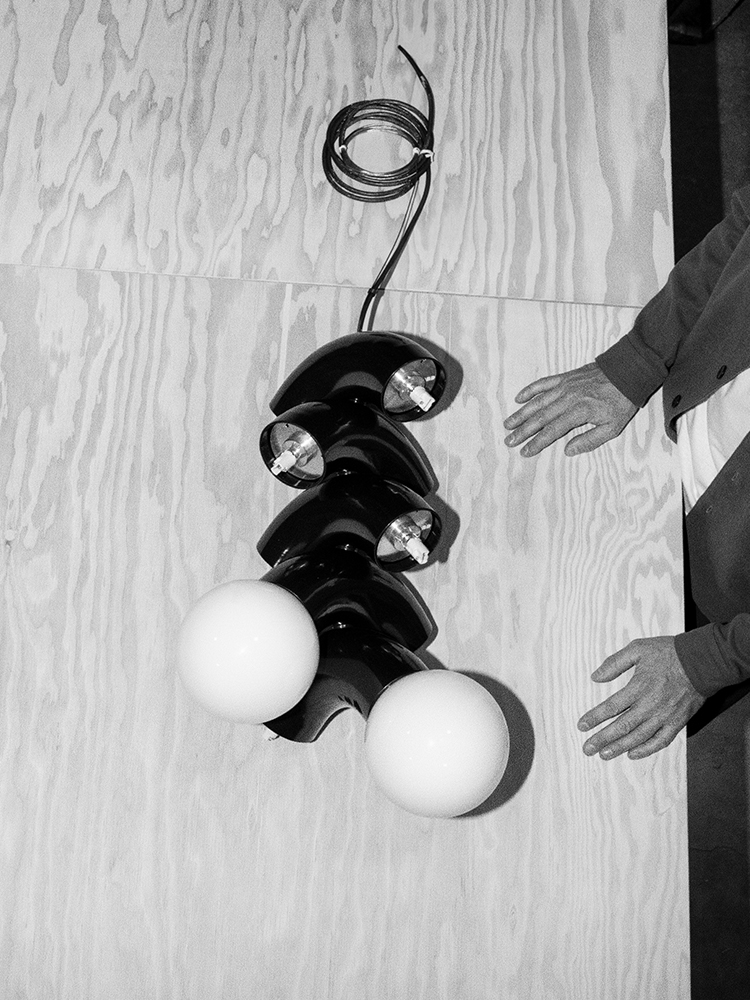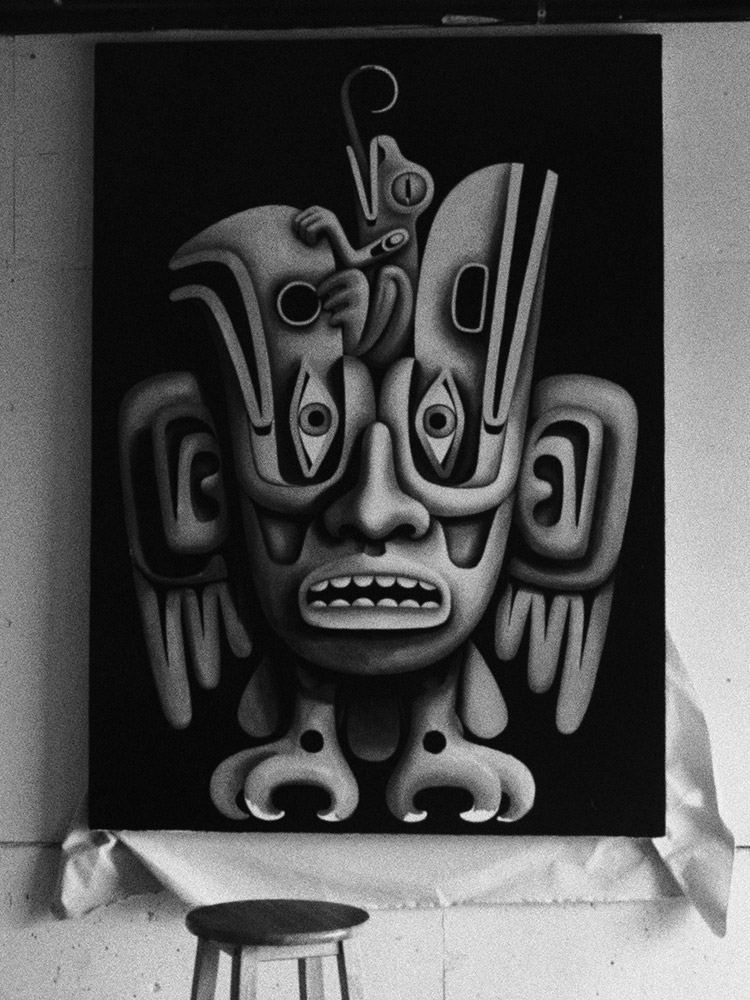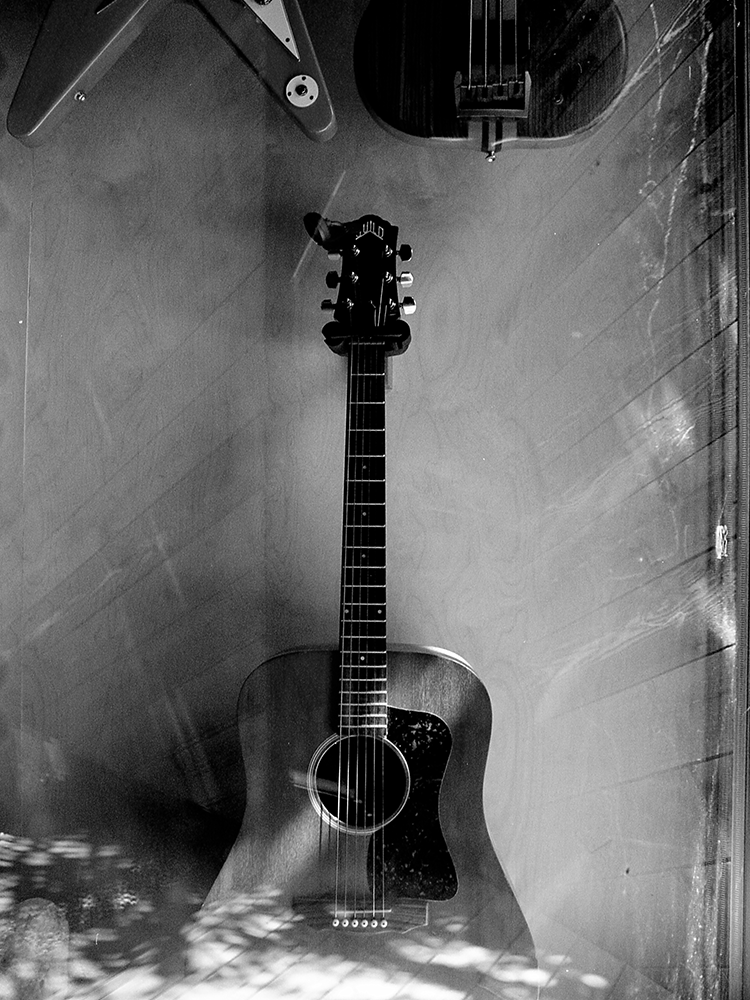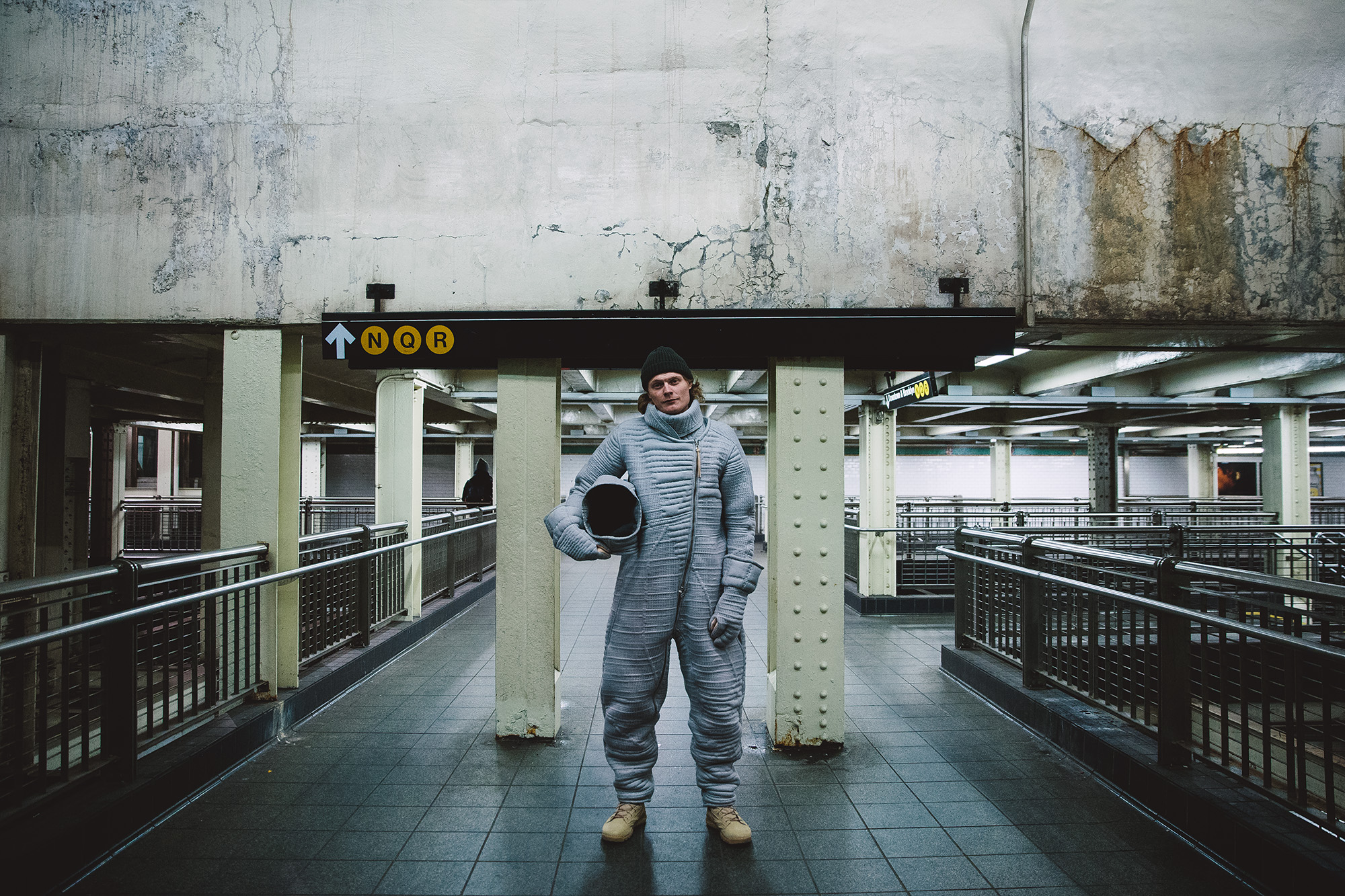
Borre Akkersdijk is a visionary textile developer. He creates innovative multi-dimensional fabrics at byBorre, his Amsterdam design studio, using technology traditionally found in the Scandinavian mattress and upholstery industry.
This season wings+horns collaborated with byBorre on a pair of limited edition bomber jackets, made with custom fabric produced at Akkersdijk’s lab on a circular knitting machine. The following conversation took place during his first trip to the wings+horns design studio in Vancouver, where a one-of-a-kind space suit inspired by the Fall/Winter 2015 collection was completed.
—
When did you first encounter the mattress technology you’re using to produce textiles?
I started out with the mattress industry while I was still in school in Eindhoven. I was doing a lot of weaving with crazy thick yarns for Maarten Baas, I made a special blanket for him, and two carpets. But at a certain moment I came into knitting, and knitting was next level. The funny thing is, the machines, they were so simple and only jersey came out. I saw so many opportunities, that’s why I started pushing it. But then I realized how difficult it was to write the programs, to understand the development and the machines. It’s a lot more difficult than the weaving process.
My department was called Man and Identity, it was really about creating atmospheres and inspirational forecasts, so I was always looking for materials. For my graduation I wanted to create a sitting object, a stool, but from textile. I started looking around for materials, and because I was layering it, I didn’t want to just use old materials. Then I was invited to see a factory that does work for Auping and Ikea, and the moment I walked in, day one, I was like ‘I want to make clothing from this.’ The week after I rewrote one of their programs and within four weeks I had my first design out.
It was super fast.
How did you get access so quickly?
There was a little part of the company that broke out, and they were working from the mattress industry towards interior design. They were developing with new brands like Established & Sons, Moroso, all the really forward interiors brands, and they found my idea cool and loved my vision. They saw what I did at the textile lab with weaving and they thought, ‘Hey, just let this guy play.’ I had loads of problems within the factory later, because the manager pushed it and the factory workers were like, ‘It’s not working.’ For more than one and a half years, when my name was dropped in the factory they were just like ‘Borre? No.’ But the textile lab saw the work and they had a machine nobody was working on, so I got the opportunity to work on it. They gave me an assignment and said, ‘Borre, make a collection, we’ll keep one and you get one.’ So that was the chance I had to really develop, and that was through other designers who gave me the opportunity to work in the textile lab. They gave me a small chance, I took it, and built it out.
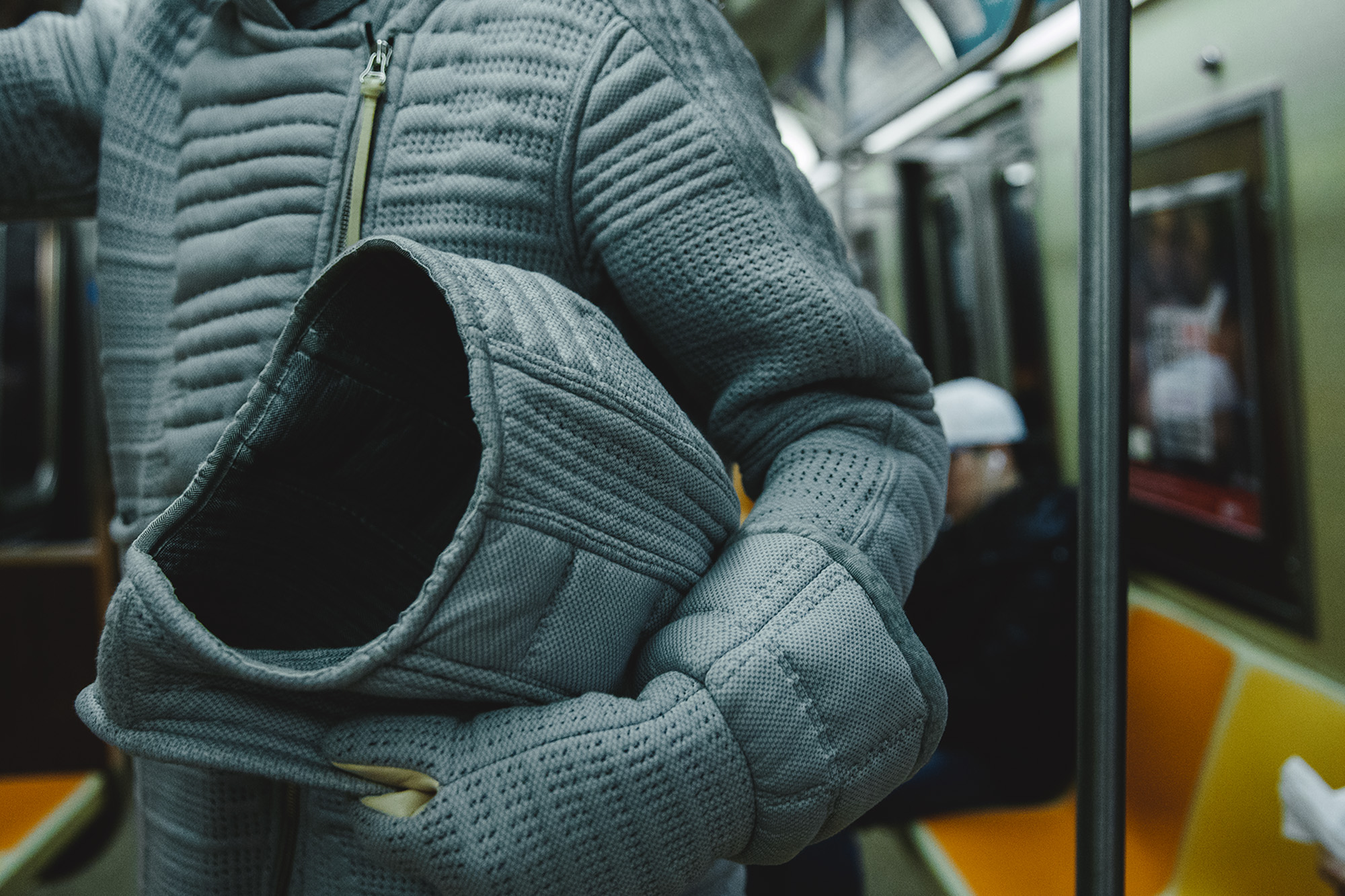
How much did you modify their existing technology for what you were doing?
Quite a lot. First the materials, then writing the programs took a different mindset. I had to figure out how big it could be, what we could change, and bit by bit I figured out how I could change the styles and shapes. They’d never worked with shrinkage and now the shape had to be exact. There was a lot of calculating, and to this day I still have to make samples every time. I finished the styles for you guys differently, and it totally made the shrinkage different. The hard thing is you work from the yarn on, and every yarn works differently. I’ll use different cotton, wool, nylon, and every time it affects the whole program. If the stitch is a bit tighter, it will affect the whole program. So first it’s about developing the look, sampling it, and then redesigning it.
Who works on the programs, is it only you?
No, there are a few steps. First I think of the concept, then me and my graphic designer work on the look, then me and the technical guy work on the machine, and then I do the colourways. It’s really about working together with the machine, not just pushing the button and letting it roll out. Bit by bit we’re getting there. My graphic designer is totally into it, he knows everything exactly, same with my technical guy. I always thought it would be difficult to change, but I was just developing in Shanghai where I had a different graphic designer and a different technical guy, and it was still working. I did projects, and let other people do projects, and it became totally different. That’s also why I’m not scared to share the story, there are so many aspects. You can do the same steps, and maybe know the techniques, but that doesn’t mean you know what happens in the end. It’s not an overnight thing.
The company you worked with in Shanghai, is that the same company you’ve been working with in the Netherlands?
No. In the Netherlands I work on a German machine and in Shanghai they are Italian machines. But the company in Shanghai produces the machines, so that’s also a step ahead of making textiles. When we start working from the yarn, we are also working and changing the machines on the spot.
When did you make that leap, from working with the machine to actually working on the machine?
Only in the middle of 2014, and that was a huge step.
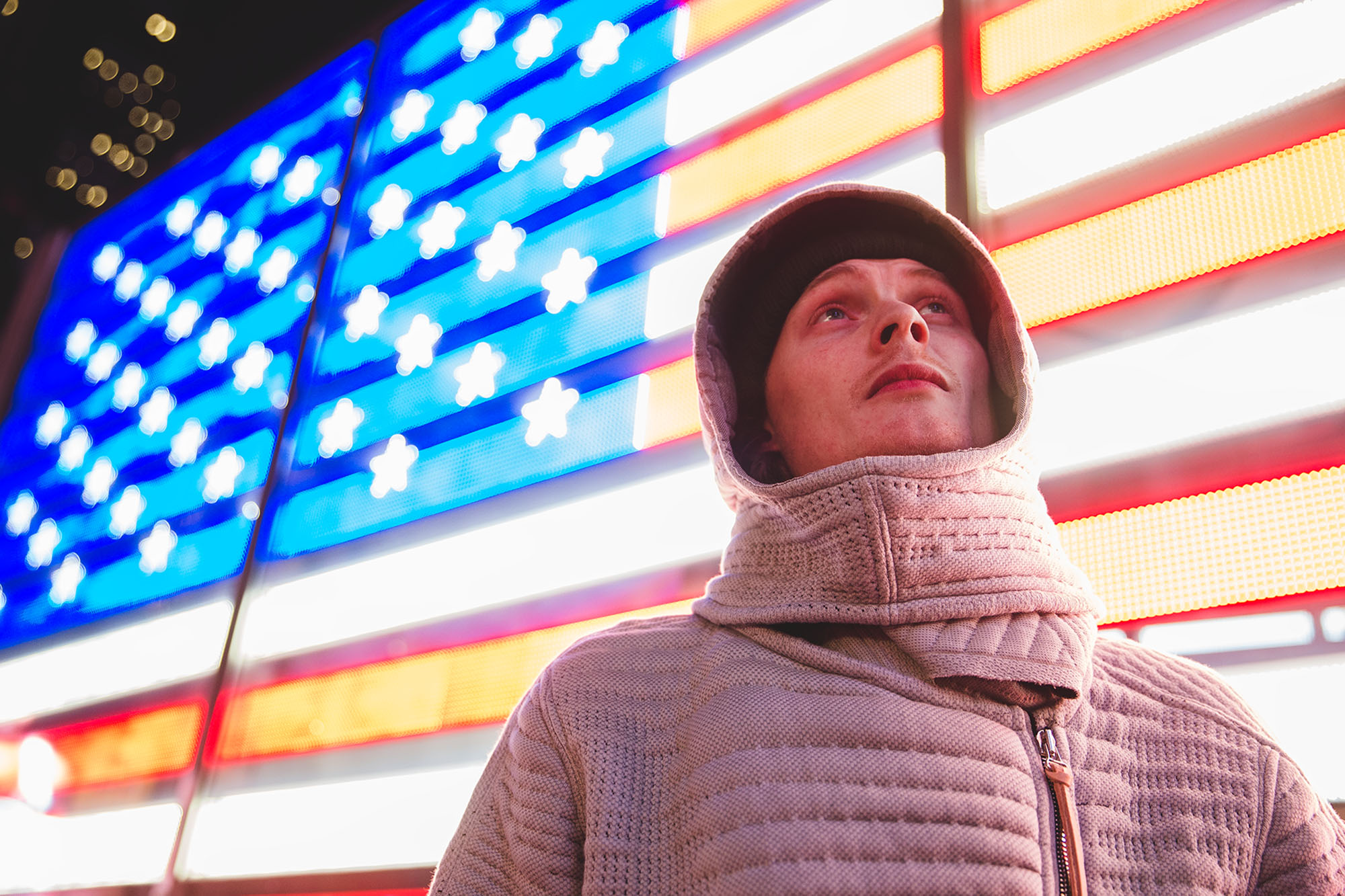
I’ve noticed you’re careful to refer to yourself as a textile developer instead of a fashion designer, and I think I’m beginning to understand why.
The moment you get the stamp of fashion designer, people expect you to push out a new product every half year. That’s not my vision. I believe research is more difficult, it takes longer. It’s also why I believe, if companies do their own thing, one small collection a year is more than enough. Because you have all these other things you can explore, where you can gain in new situations. I think that’s also part of why I was really interested in wings+horns. Even on products where I don’t know the whole story behind them, I can see there was development in the textiles, and that some of the designs were from the material on, not shape on. That’s something you feel, and when you look into it, it’s way more interesting. I felt we had the same mindset and approach.
It’s exactly how we’ve been working here this past week. Look at the material, look at what we can do, look at the finishing. I’ll sketch a bit, make a quick pattern, Tung will adjust it a bit, and it’s really organic, it just grows and becomes better. It leaves more space for interpretation of the material and the shape, and that’s exactly how I develop my materials. I put something in, I pull some strings, I push the machine, and if it fails it does not fail. It becomes something else.
Exploring possibility seems like an important element of your work… What possibilities do you see for the textiles you’re developing?
Six years ago I made the first pieces, and after a year I was totally done with it. I did my Paris Fashion Week and there was a moment when I was totally finished. I went full circle, I made it, on to the next project. But every time I think I’m finished, it’s actually the beginning of a new thing, so it’s like a circle. And because there are more dimensions to the fabric, because we can make it thin or thick, it leaves space in the middle to put different fillings that react differently, and it leaves space front and back to apply different materials. So not only the look, the colour, the feeling, the thickness, but also the inside and the handling of the material, all have options to vary. There are way more options than just a plain fabric.
You’re designing in six dimensions.
Yes. With this fabric for wings+horns, if I used a stronger textile it would have a totally different look. I have some sample rolls where the graphic is exactly the same but every 10cm I changed the yarns, and it goes from nylon to wool to cotton to transparent fibre, and everything is totally different. The possibilities are immense, which is why I have become way less scared of sharing. I could work in one season with 10 brands that look like each other, and for any one I could do something totally different that everyone would recognize as byBorre. Because I always push it further by myself, because I don’t have a retail line and I don’t have to, I will always be a step ahead. Even now, with the wearable tech and me talking to Nike, they will help me push it further. I will take my information in, work with them, and then I have all the information too. And for a single product, which will never hurt them, I can push it out through my own developments.
I would never cross anybody, that’s my whole base, you need to be honest. That’s why people take care of me, because I’m honest about it. It just brings the whole thing further. I think the opportunities for this textile are immense. The whole mindset of working with the machine from the yarn on, from the beginning, I do that with any kind of machine now. I’m learning way more techniques. The more I do, the easier it actually gets. The struggles I had a few years ago… It’s not that I’m not struggling now, but at first I was struggling, and I knew I was doing something good, and the recognition was there but it wasn’t working. Now it’s working, the recognition is there, I’m choosing partners to work with, and I think the coming years are going to be easier and easier.
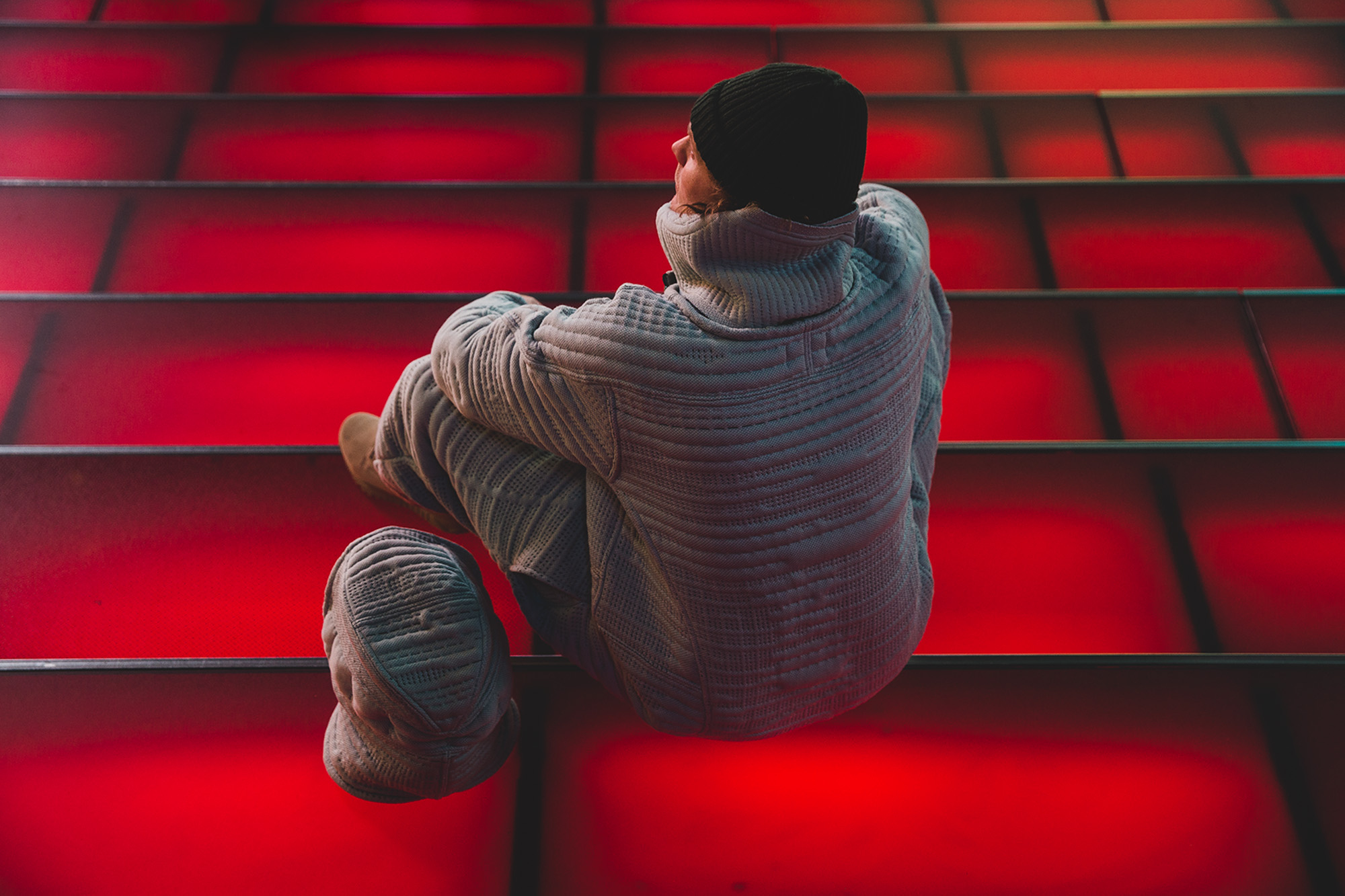
You received quite a bit of recognition for the ‘BB.Suit 0.2’ clean air suit, and now you’re here making a wings+horns space suit. What is it that attracts you to full suits?
Because material is the base, a lot of times material becomes the shape. When the material is thick and strong, the shapes have to become bigger and stronger. I like jumpsuits and big suits. You can work with sizing, and because it’s so not casual to wear a whole jumpsuit, especially not six years ago, aesthetically it becomes more appealing just because it’s different. For me it was really important to give the material the space, but then also the shape, to enhance the feeling of it. Every time I start designing I think I’m going to make something for myself, but it ends up way more crazy because it would not be good for the textile to only make a simple piece.
Is that also how the concept for this spacesuit came together?
It was really natural. We did the textile and were talking about doing a show piece, and I said, ‘Ok, if we’re going to do a show piece then I want a big suit, because that’s my world. You guys do the pattern and give it to me totally empty, then I’ll make the textile the way I do it normally, so it’s my world.’ That was really important, and if I can do that then I can really make it extreme because I don’t have to think about cut and sew. I did the colour more or less the same on purpose, but with a lot of the other things I was more free. So then Tung said we should do boots, and then while we were here we had fabric left over so we made gloves. It was a really natural flow of possibilities, and when I get enthusiastic I think my time is worth it.
I see the opportunities, and I get the chance to see other amazing brands that do their thing really well. Yes I can maybe make amazing materials, and for the world it’s something new and crazy and artistic, but I’m learning so much from being inside a small organization like wings+horns that is structured and putting out collections and making that possible. At the same time I’m learning from huge corporations that do things totally different, like Nike, and that’s totally worth it. There’s always such a relationship that I know if I ask, ‘How can I do this the smartest?’ I will get an honest answer, and most of the time they will help me, and that’s the world I want to live in.
You don’t seem to be afraid of colour, and your machines have the ability to integrate so many colours into one piece…
The funny thing is, I am a bit afraid of colour, but when I don’t use it… I never choose the colour, and it’s never on purpose. The moment I’m working with the machine, when I just let it run, I’m not working with it. It’s doing the work. But I want to work with it and I start integrating things. I integrate one cone, then I think another fits with it and I just start adding. It’s a natural process where things I could never have thought of happen, and I could never make an exact replica of the crazy things I do, but I can make the same feeling, and that makes it interesting. A few of my first pieces were all one colour, and it was interesting, but for me you always have to push things as far as you can before you can get back to the easy stuff. That’s the logic to doing it. I think the suit we made as a collaboration, it’s as strong as it is because I’ve already done things that are more extreme. So it totally fits and you can see where the two worlds come together.
If you look at any exhibition we’ve done, it’s always built on the space, it’s always interacting with the space. My show in Paris… They asked me to do it in a gallery and it became a totally new world. Then two Japanese guys came to the show and said, ‘We want this in Tokyo,’ but in Tokyo it was totally different. So it always adjusts to the moment, and every location, every person, every brand, has influence on it. That has been my strong point and now I realize it more, so I always take it in. When people call me to use my fabric, I will always say no. Doesn’t matter who you are. You can work with me and we can create something together, but I’m not a textile company, I’m a textile developer that comes up with new things. Of course if it becomes bigger we’ll need to integrate the factory more and scale it up, because there’s nothing better than when the world can buy a piece of it and feel it and gain that relationship.
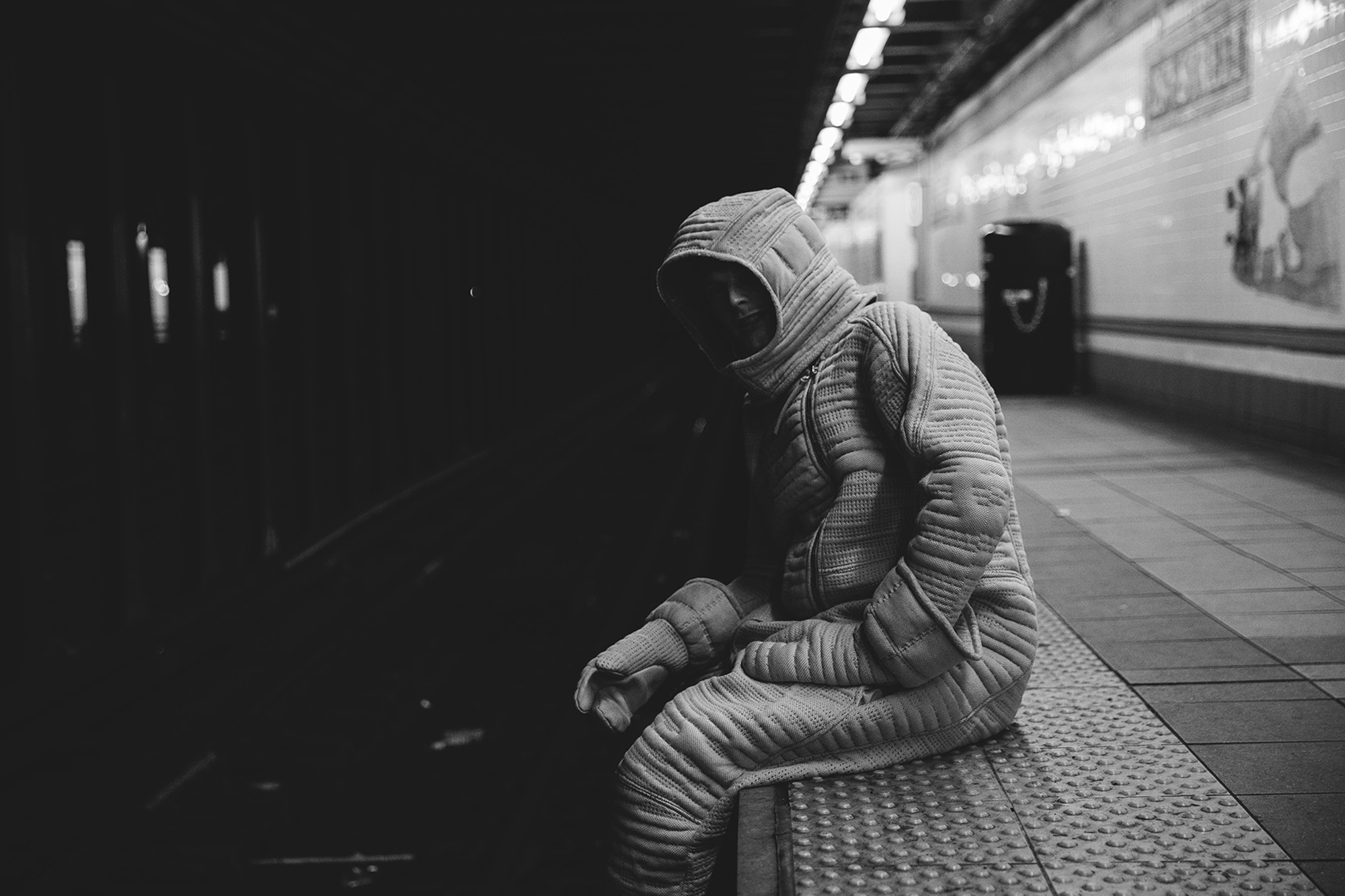
You’ve spoken about relationships with a lot of care, and earlier you referred to your collection and the design process as a circle. What’s the story behind your logo, the imperfect circle?
That’s a nice story actually. I did not want a logo, I don’t like logos. I don’t like difficult names. It is what it is, but it’s also quite a Dutch thing. My Grandma always used to say, ‘Just act normal, you’re crazy enough.’ It’s a nice thing sometimes, but it also makes everything a bit flat. That happens in the Netherlands, and in Scandinavian countries also. When I graduated and finished my first collection I asked my graphic designer Dan what we should do, and he said ‘You need a corporate identity, and I know you don’t want a logo, but at least we need a name. Even just a typeface that we can start with.’ So I thought, lets go with ‘door Borre,’ because that’s ‘by Borre’ in Dutch. I didn’t want it to have only my first name, and because my first name is a bit strange I thought if I make it byBorre, it’s a strange word anywhere, and if people don’t know me personally they won’t even know the words are separate from each other.
So I went to Dan’s office and he had a few A3’s with typefaces. He put a sharpie down and I was crossing out, ‘No, no, no,’ and then I circled one. He told me it was a Dutch guy who made it, and then he was like, ‘Wait, wait, go make coffee, I’ll be right back.’ So he scanned it in, made a vector out of it, put it above the type, printed it, put it on the table folded and said, ‘I know you don’t want a logo, so I did not make a logo. If you’re not going to use what I made, it’s cool, but we’re not going to work anymore. Because for me this is so on-point, if you don’t like it we don’t understand each other.’
What happened was things really coming together. You always ask people around you for help if you think they can do something way better than you. I know his graphics are way better, his concepts are super good, so I asked him. This happens with anything, textiles or whatever, and Dan told me, ‘You always pull people together and mix it.’—In Dutch we say, ‘you will make the circle round,’ by putting the people in place, and directing them.—‘This is exactly what happened with the text. You asked me, we talked about it, you asked people around you, you looked through it and you selected. With your circle of selection, that’s your circle and nobody can touch it. That’s it. Because it’s your circle and it’s imperfect, it will always be yours, and everybody will recognize it.’ The circle is an easy thing to choose, it’s not a logo, but this was not a choice. It came together. So that was also the story we talked about in the first collection, because of this it was called ‘The First Cycle.’ The cycle from the yarn to the show.
Perfect. Not to mention you work with a circular knitting machine.
In so many ways it became perfect. As a joke we said, ‘We’re going to make a brand, we’re going to do crazy stuff, but on the side we will try to claim the circle.’ And that’s one of the most crazy things you can say, because you cannot claim the circle.

